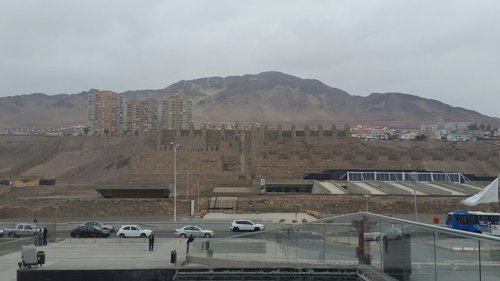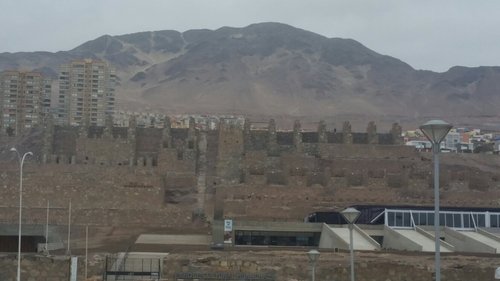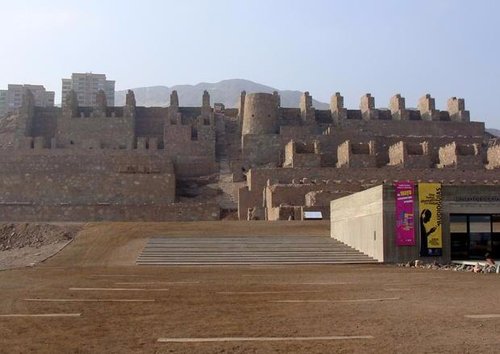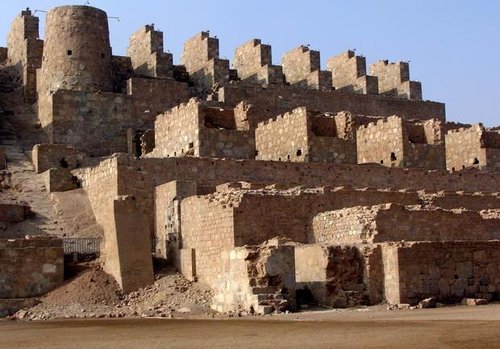Ruinas de Huanchaca, Antofagasta Region, Chile
4.0 (392 reviews) Spent Ranking #4 in Antofagasta Speciality Museums

Just another Ruins
It's a big place. But I didn't see anything that was fascinating to me. The only thing it's a great view from the Hotel Casino Enjoy


Address
Angamos Frente al hotel Enjoy, Antofagasta, Chile.
Mobile
Website
http://ruinasdehuanchaca.cl
Current local date and time now
Friday, May 10, 2024, 16:01
User Ratings
4.0 based on (392 reviews)
Excellent
46%
Good
35%
Satisfactory
16%
Poor
2%
Terrible
1%
Reviews
-
4Isolar2014 5:00 PM Jan 19, 2016
Ruins of Huanchaca and Atacama Desert Museum
The historic landmark known as Ruins of Huanchaca corresponds to the vestiges of an old silver smelter that operated in Antofagasta, Chile, between 1892 and 1902, which was in its time the largest industrial complex in South America. The massive constructions built of "andesite" stone are the structural foundations of the former industrial establishment called "Playa Blanca" (White Beach). This was a property of the “Mining Company of Huanchaca – Bolivia” (a company of Chilean, British and Bolivian interests). Huanchaca owned silver mines in Pulacayo and Oruro, approximately 750 kilometers northwest in Bolivian territory, from where the ore came by train to the port of Antofagasta on the Pacific coast for processing and shipping. Construction of the plant began in 1888 following an agreement between the Mining Company of Huanchaca and the British-Chilean “Nitrates and Railway Company of Antofagasta” to transport the ore from the Bolivian mines to the smelter at Antofagasta. The industrial complex opened in 1892 and from February 1893, received 200 tons of material per day, which produced 3.85 tons of silver per month. The industrial facilities involved machinery buildings, boilers and engines, workshops, gas works, pumps and tanks, warehouses, offices, and living quarters for more than 1,200 workers. The company made valuable contributions to the development of the city of Antofagasta such as the completion of the railroad from Antofagasta to Bolivia, the supply of drinking water through pipelines from the Andes Mountains, a rudimentary telephone network and street gas lighting. After only 10 years of operation, due to the instability of silver prices in the world market and a great flood that paralyzed the site at Pulacayo, the company ceased business in 1902. After closing and decommissioning, the facilities were abandoned to the impacts of time and weather. In 1964, the ‘Catholic University of the North’ undertook the task of conservation of the ruins and the development of the Huanchaca Cultural Park including the Ruins of Playa Blanca, the Atacama Desert Museum, and an outdoor amphitheater open to the community to be used for public concerts and mass artistic performances. In 1974, the Huanchaca Ruins were designated a The Atacama Desert Museum has a floor area of 2,200 square meters. Beyond a large entrance hall there are five permanent exhibition halls, a central corridor also used for exhibitions, an auditorium for 99 people, offices, a warehouse, and research spaces. The Museum aims to preserve and increase the knowledge and dissemination of the natural, archeological and historical heritage of the Antofagasta Region. Access to the Huanchaca Ruins is free. The Museum is open Tuesday to Sunday from 10:00 to 13:00 hrs. and from 14:30 to 19:00 hrs. Entrance fee is CLP$ 2,000 (approx. USD 2.8).


-
4Katrien S 5:00 PM Feb 28, 2020
Very atmospheric ruins of a silver melting factory
Very nice ruins, certainly near sunset when they turn reddish. On the grounds of these ruins a little museum was build. The architecture of the building is very well done. Inside there is some information about mining in the region, as well as a nice mural dedicated to the miners. There is also information about geology and local more recent history, as well as astronomy. Has limited opening hours.
See also
More Things to do in Antofagasta
- Points of Interest & Landmarks in Antofagasta
- Churches & Cathedrals in Antofagasta
- Historic Sites in Antofagasta
- Ancient Ruins in Antofagasta
- Speciality Museums in Antofagasta
- Parks in Antofagasta
- Mountains in Antofagasta
- Piers & Boardwalks in Antofagasta
- Nature & Wildlife Areas in Antofagasta
- Spas in Antofagasta
- Speciality & Gift Shops in Antofagasta
- Private Tours in Antofagasta
- Taxis & Shuttles in Antofagasta
- Lookouts in Antofagasta
- Monuments & Statues in Antofagasta
- Neighborhoods in Antofagasta
- Bodies of Water in Antofagasta
- Geologic Formations in Antofagasta
- Beaches in Antofagasta
- National Parks in Antofagasta
- Game & Entertainment Centers in Antofagasta
- Scenic Walking Areas in Antofagasta
- Shopping Malls in Antofagasta
- Observatories & Planetariums in Antofagasta
- Flea & Street Markets in Antofagasta
- Ghost Towns in Antofagasta
- Bus Services in Antofagasta
- Theatre & Performances in Antofagasta
- Volcanos in Antofagasta
- Cemeteries in Antofagasta
- Valleys in Antofagasta
- Deserts in Antofagasta
- Libraries in Antofagasta
- Arenas & Stadiums in Antofagasta
- Hot Springs & Geysers in Antofagasta
- Casinos in Antofagasta
- Civic Centres in Antofagasta
- Rail Services in Antofagasta
- Auto Racing Tracks in Antofagasta